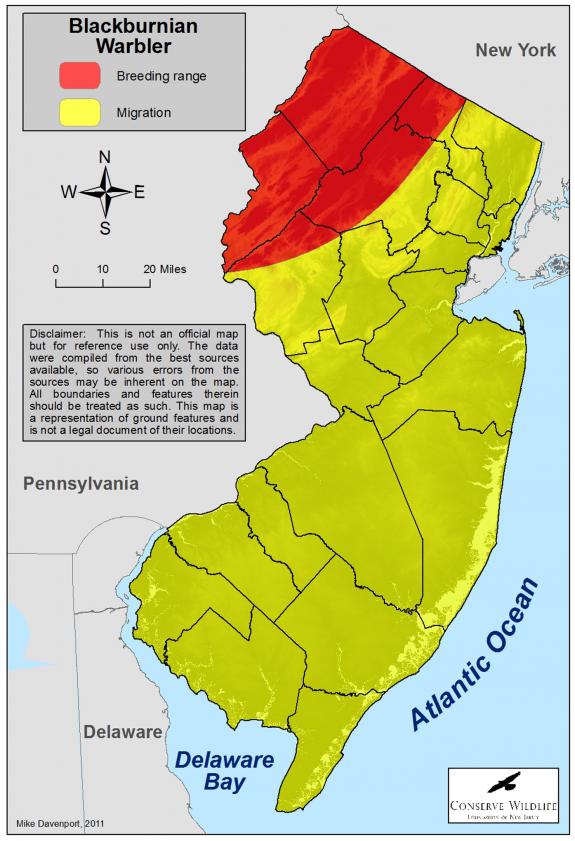Dendroica fusca
Type: bird
Status: special concern
Species Guide
Blackburnian warbler
Dendroica fusca
Species Type: bird
Conservation Status: special concern
IDENTIFICATION
The blackburnian warbler is a small migratory songbird about 5 inches in length. The male is black and white above with flaming orange on the throat. The male’s head is orange with a black triangular cheek patch. The belly is a pale yellow to white with several black streaks along the sides. The female is paler in color and has some pale orange on her throat.

Distribution & Habitat
The breeding range of the blackburnian warbler extends from southeastern Canada in the north to the northern U.S. Midwest and Mid-Atlantic states and extends southwesterly along the Appalachian Mountains as far south as northern Georgia. It winters in northwestern South America along the Andes Mountains and migrates throughout Central America, eastern Mexico, and the eastern half of the U.S.
Breeding habitat includes coniferous and mixed forests, open woodlands, and second-growth habitat. They prefer forests with tall trees. During the winter, their habitat consists of forested areas of foothills and mountains. They are most commonly observed in the upper third of the forest canopy.
Diet
Blackburnian warblers eat insects as well as some berries. They usually feed high in the tree canopy on the outer tips of branches. They may also feed by flycatching.
Life Cycle
The breeding season for the blackburnian warbler in New Jersey is between early May and mid-August. Nests are built by the female on the tips of high branches of trees (usually conifers) and usually consist of twigs, bark, rootlets, and plant fibers held to the branch by spider webs. The nest is often lined with lichens, moss, and dry pine needles. 4 to 5 eggs are laid in May or June and incubation lasts about 12 days. Incubation is by the female and the young are tended to by both parents.
Current Threats, Status, and Conservation
The blackburnian warbler population is generally stable throughout most of its range. However, it is listed as a Species of Special Concern in New Jersey (not yet endangered or threatened but possibly on its way). This species is sensitive to loss of mature native forests. Local declines in their population are most likely due to loss of those old-growth forests as well as forest fragmentation.
Preservation of large areas of intact mature forest habitat benefits this species. Conservation of New Jersey’s warbler species requires long-term monitoring and research, habitat preservation and restoration, reduction in mortality caused by humans, cowbird control, and incentives to promote habitat preservation within their wintering areas.
References
Text written by Michael J. Davenport in 2011.
Scientific Classification
- Kingdom: Animalia
- Phylum: Chordata
- Class: Aves
- Order: Passeriformes
- Family: Parulidae
- Genus: Dendroica
- Species: D. fusca